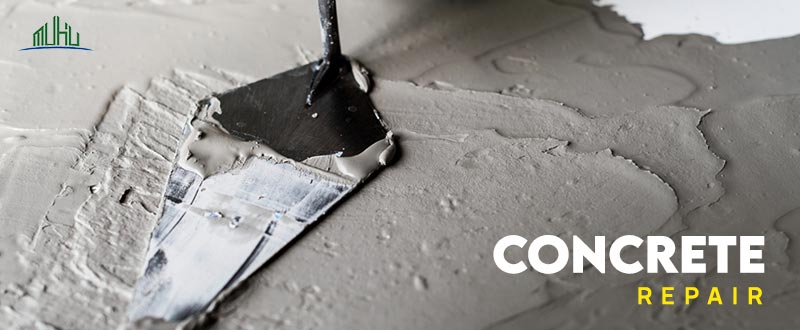


Concrete is one of the most widely used construction materials due to its strength, versatility, and long lifespan.
Concrete is one of the most widely used construction materials due to its strength, versatility, and long lifespan. However, even the most durable concrete can deteriorate over time due to weather, chemical exposure, structural loads, or poor workmanship. That’s where concrete repair materials come in — to restore, strengthen, and protect damaged concrete surfaces for years to come.
If you’re looking for high-quality concrete repair solutions, explore the range of professional-grade materials available at MUHU USA, a trusted manufacturer and supplier of construction chemicals and admixtures.
Before choosing a repair method, it’s important to understand why concrete fails. Common causes include:
Moisture and freeze-thaw cycles – Repeated freezing and thawing cause expansion and cracking.
Corrosion of reinforcing steel – Chlorides and moisture lead to rusting, which expands and cracks the concrete.
Chemical attack – Exposure to sulfates, acids, or alkalis weakens the concrete matrix.
Structural overloads – Excessive loads or impacts can cause cracking or spalling.
Poor construction practices – Improper curing, mixing, or finishing often lead to premature deterioration.
By identifying the root cause, you can select the right concrete repair material that addresses both the symptom and the source of the problem.
Depending on the extent and nature of damage, concrete repair may involve one or more of the following methods:
Crack injection involves sealing fine cracks using epoxy or polyurethane resins. This restores structural integrity and prevents water ingress. Epoxy is preferred for structural repairs, while polyurethane is ideal for flexible or non-structural applications.
For localized damage such as spalling or scaling, cementitious patching compounds are applied to restore surface profile and protect against further degradation.
When large portions are damaged, concrete sections can be recast or jacketed using new material reinforced with steel or fiber to restore load-bearing capacity.
Polymer-modified mortars or overlays provide excellent adhesion, flexibility, and chemical resistance. They are ideal for bridge decks, floors, and industrial surfaces.
To extend lifespan, corrosion inhibitors, protective coatings, or fiber-reinforced polymers can be applied to strengthen the existing structure and resist future damage.

Choosing the right material is key to a durable repair. MUHU USA offers a complete line of high-performance concrete repair products designed for commercial, industrial, and infrastructure projects.
Epoxy resins provide superior bond strength, chemical resistance, and durability. They are perfect for repairing cracks, bonding new to old concrete, and structural strengthening.
Applications:
Advantages:
These materials combine cement and polymer additives to improve flexibility, bonding, and resistance to moisture and chemicals. They are ideal for vertical and overhead repairs.
Applications:
Advantages:
High-strength, non-shrink grouts are used to fill voids, anchor bolts, and repair large cavities. They provide excellent load transfer and dimensional stability.
Applications:
Advantages:
Incorporating fibers into repair mortars improves crack resistance and flexural strength. These materials are especially useful in heavy-duty industrial floors and bridge decks.
Advantages:
After repairing concrete, applying protective coatings is essential to prevent water, chemical, and UV damage. MUHU offers a range of epoxy and polyurethane-based coatings for long-term protection.
Benefits:
A successful concrete repair job requires proper surface preparation, material selection, and application technique. Follow these key steps:
Assessment and Diagnosis
Identify the extent and cause of damage using visual inspection and testing.
Surface Preparation
Remove all loose, deteriorated, or contaminated material to expose sound concrete. Clean the surface thoroughly.
Material Selection
Choose the appropriate MUHU concrete repair product based on structural needs, exposure conditions, and load requirements.
Application
Mix and apply the repair compound as per manufacturer’s instructions, ensuring proper bonding and compaction.
Curing and Protection
Allow the repair to cure adequately, and protect it from rapid drying, freezing, or chemical exposure.
Post-Repair Coating
Apply a protective coating or sealer for enhanced durability and resistance to environmental factors.

When it comes to reliability, MUHU’s concrete repair systems are engineered for performance and longevity. Here’s why professionals choose MUHU:
MUHU’s concrete repair materials are trusted across diverse sectors:
Whether you’re repairing a small crack or restoring large structural damage, MUHU products provide the strength, durability, and quality needed for professional results.
Concrete repair is not just about fixing damage — it’s about restoring performance, extending lifespan, and preventing future deterioration. With MUHU USA’s high-performance repair materials, you can achieve lasting results that combine strength, aesthetics, and sustainability.
Visit MUHU USA – Concrete Repair Materials to explore premium products designed for every type of repair, from minor patchwork to large-scale restoration. Strengthen your concrete structures today and ensure they stand the test of time.
Regular concrete maintenance and timely repairs are essential to preserve the structural integrity of buildings and infrastructure. Neglecting minor cracks or surface damage can lead to costly structural issues over time. Using advanced repair materials like epoxy compounds, polymer-modified mortars, and protective sealers ensures durability, aesthetics, and safety. MUHU USA’s specialized concrete repair products not only restore damaged surfaces but also enhance long-term performance against moisture, corrosion, and environmental wear. Whether for bridges, industrial floors, or residential foundations, choosing the right repair solution from MUHU ensures superior strength and sustainability for all types of concrete structures.
